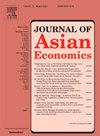AI-driven unemployment risk and household financial decision: Evidence from China
IF 3.4
3区 经济学
Q1 ECONOMICS
引用次数: 0
Abstract
This paper examines unemployment risk driven by artificial intelligence (AI) on household risky asset investment, focusing on how labour market risk affected by AI influences financial decisions in Chinese household. Using 2016, 2018, and 2020 data from the China Family Panel Studies (CFPS), we analyze the relationship between unemployment risk, qualified by the probability of AI replacing occupations and household decisions in financial risky asset investment, constructing the Probit and Tobit models. After several methods dealing with endogeneity issues, we find a positive effect of unemployment risk on household decisions, especially among highincome households, who are more likely to invest in risky assets to hedge against potential work loss. Furthermore, we also find that material aspiration is essential in moderating these investment behaviours. This study provides the first empirical evidence of unemployment risk as a determinant of household risky asset investment in China, utilizing forward-looking data to measure labour market uncertainty across occupations and complementing the 'participation puzzle' explanation for emerging economies. Additionally, it pioneers micro-level analysis of AI-induced unemployment risk, revealing its influence on household financial decisions and introducing the unemployment risk--material aspiration--risky asset investment framework, which expands the understanding of AI's microeconomic effects.
人工智能驱动的失业风险和家庭财务决策:来自中国的证据
本文考察了人工智能(AI)驱动的失业风险对家庭风险资产投资的影响,重点研究了受人工智能影响的劳动力市场风险如何影响中国家庭的财务决策。利用中国家庭面板研究(CFPS) 2016年、2018年和2020年的数据,我们分析了失业风险与家庭金融风险资产投资决策之间的关系,以人工智能取代职业的概率为条件,构建了Probit和Tobit模型。在处理内生性问题的几种方法之后,我们发现失业风险对家庭决策有积极影响,特别是在高收入家庭中,他们更有可能投资风险资产以对冲潜在的失业。此外,我们还发现物质渴望在调节这些投资行为中至关重要。本研究首次提供了失业风险是中国家庭风险资产投资决定因素的经验证据,利用前瞻性数据衡量了不同职业的劳动力市场不确定性,并补充了新兴经济体的“参与之谜”解释。此外,它还开创性地从微观层面分析了人工智能引发的失业风险,揭示了其对家庭财务决策的影响,并引入了失业风险-物质渴望-风险资产投资框架,扩大了对人工智能微观经济效应的理解。
本文章由计算机程序翻译,如有差异,请以英文原文为准。
求助全文
约1分钟内获得全文
求助全文
来源期刊

Journal of Asian Economics
ECONOMICS-
CiteScore
4.70
自引率
9.40%
发文量
90
期刊介绍:
The Journal of Asian Economics provides a forum for publication of increasingly growing research in Asian economic studies and a unique forum for continental Asian economic studies with focus on (i) special studies in adaptive innovation paradigms in Asian economic regimes, (ii) studies relative to unique dimensions of Asian economic development paradigm, as they are investigated by researchers, (iii) comparative studies of development paradigms in other developing continents, Latin America and Africa, (iv) the emerging new pattern of comparative advantages between Asian countries and the United States and North America.
 求助内容:
求助内容: 应助结果提醒方式:
应助结果提醒方式:


